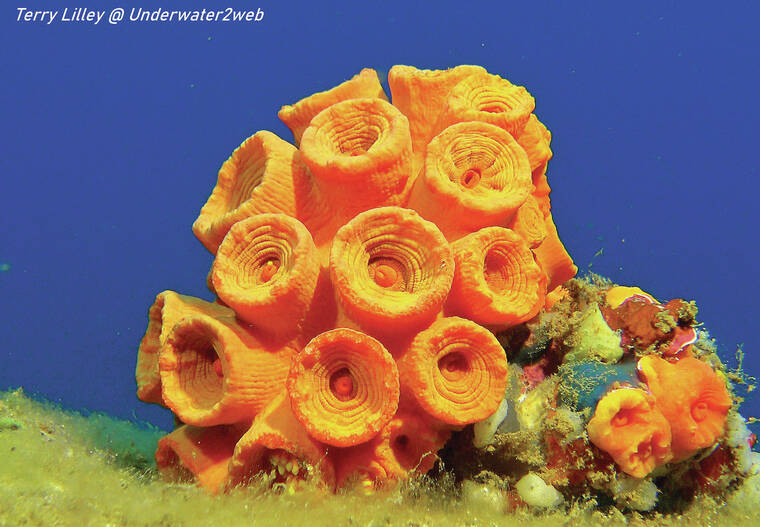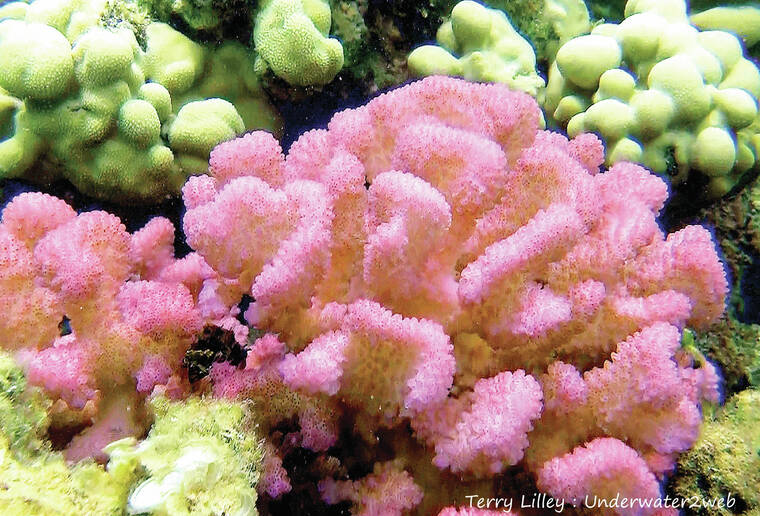When we are out snorkeling here in Hawai‘i, we all see hard stony coral that has different colors. Coral is made up of a hard calcium carbonate structure that is similar to the concrete we build condominiums out of on land. The hard calcium structure protects the soft clear coral polyps from being washed away in the surf, much like a house on land protects soft bodied humans from washing away in a storm.
Shallow water corals grow algae in their soft tissue called zooxanthellae, much like you may have a vegetable garden you grow at home. The algae is protected by the hard calcium coral skeleton and in return produces sugars through photosynthesis that help feed the soft coral polyps.
Different colored algae gives the coral its color, much like in your garden certain plant species give the garden color. One cauliflower coral may be green and another close by may be purple. Just like your spinach in your garden may be green, but your rainbow chard may be purple.
The zooxanthellae in the coral tissue secretes calcium carbonate, which helps glue corals together to make a solid coral reef that may be 25 feet thick. These reef building coral species live in shallow water where they have access to the sunshine for photosynthesis. Deeper water corals that get less sunlight are usually brown or green in color and grow very slowly, so they normally won’t produce a large coral reef.
Since live corals are white and their symbiotic algae give them their beautiful colors their algae could die and the coral becomes pure white again. This is called coral bleaching, which does not kill the coral unless it happens for a long period of time.
Just like at home, your garden could die due to a heat spell or too much rain and the soil is bare until new plants grow. Same with the algae in the coral. Mud from coastal runoff can cover the coral and kill the algae causing the coral to bleach.
Chemical runoff and a dramatic sea temperature change can kill the coral algae. To survive the coral must grow new algae so it has a food source.
In the past 10 years many of the shallow water corals are changing colors. Some have changed from brown to bright purple.
We think due to the rising sea levels shallow water corals are having a change in how much sunshine they get so they may be changing algae species that can grow better in different amounts of ultraviolet light. Just like in your home garden, certain plants may grow well in the summer when there is more direct sunshine and other plants may grow better in the winter where there is more shade.
Deep water corals or corals that grow in caves like the beautiful orange cup coral get their colors from dissolved minerals in the sea water, not from growing algae in their soft coral tissue because they do not get any sunshine. These corals do not have algae that secretes calcium carbonate, so they don’t grow very large or bond together to form a coral reef like the corals do that have direct sunshine.
As you can see a shallow water coral reef is very complex and constantly changing with the environmental changes like rising sea levels and human accelerated climate change. Every coral reef is different just like everyone’s home garden is different, so we must study each and every coral reef to understand how to protect it.
Our coral reefs are very important because they are the home to baby fish, they protect our coastline from storms and they produce oxygen we breathe, plus they are just beautiful to look at.
•••
Terry Lilley is a marine biologist living in Hanalei Kaua‘i and co-founder of Reef Guardians Hawai‘i, a nonprofit on a mission to provide education and resources to protect the coral reef. To donate to Reef Guardians Hawaii go to www.reefguardianshawaii.org.



